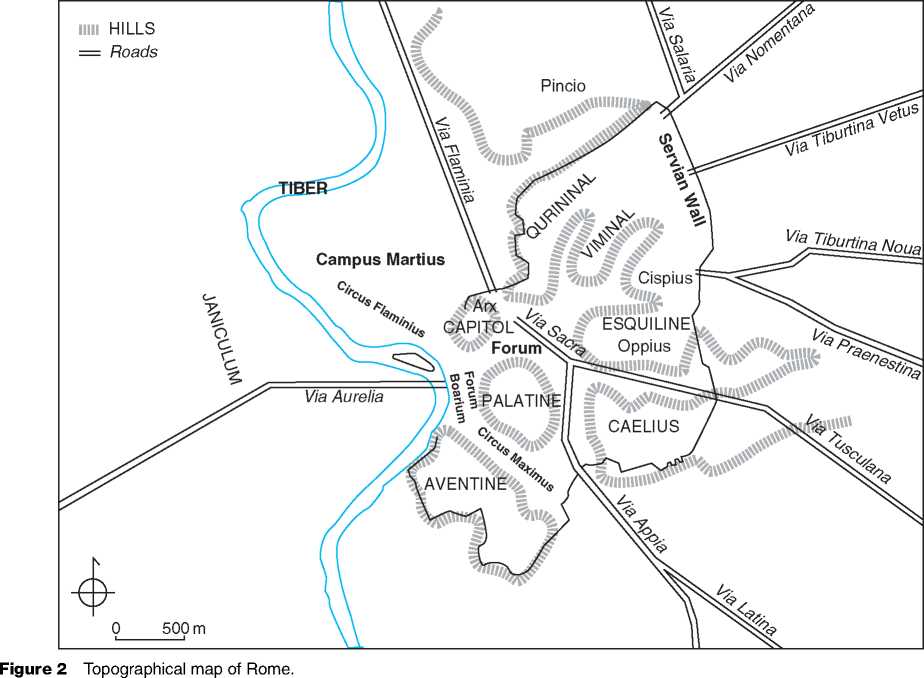The Question of the ‘Origins’
The question of the ‘origins’ of Rome is a methodological textbook case of the status still nowadays conferred to archaeology in the historical research. As a matter of fact, the ideological background at stake is a major issue. Roughly, the question is to understand how Rome became the ruler of its huge Empire, including Greece: was its destiny written as soon as it was founded? Why Rome, and not another Latial or Etruscan city? This question has been asked by the ancient historians themselves, including the Greek Polybius (e. g., 1.1.5) in the mid-second century BC and the Roman Livy, who wrote, at the time of Augustan ‘restoration’, a year-by-year history of Rome ab urbe condita, ‘since the foundation of the city’. This ideological justification of the power of the city has been regularly updated, from the pontifical states, at the head of the Kingdom of Rome up to the fascist state, which pretended to restore the ancient Empire.
This weighty historiography is even complicated by the relative scarcity, and above all the disparity, of the evidence concerning the beginnings of Rome. In that matter, archaeology is, with epigraphy, the only ‘primary’ discipline, whereas the others - ancient literature, historical annals, myths, and religious practices - offer a very rich tradition, much more emphasized than any other foundation story of the
Mediterranean area: one of the most relevant features is that the birth of Rome has not been attributed to a divine, but to a human willingness, and then immediately conceived as a politic phenomenon, confusing ancient history and earthly mythology. Yet, do the archaeological discoveries confirm or infirm the literary tradition, mostly conveyed by authors writing at the end of the first century BC (mainly the antiquarian Varro, the historian Livy, and the politician Cicero)? As such, the question seems easy to answer; in fact, the debate between hypercriticism - the quasicomplete rejection of the traditional sources, considering them as late reconstructions which cannot afford a piece of evidence - and fideism - which sees every new discovery as a proof of the reliability of ancient tradition - is far from being closed, even with the most recent and spectacular excavations of the slopes of the Palatine Hill.
Tradition Confronted to Archaeology
According to the literary tradition, Rome was founded by Romulus in 754/3 BC. He and his twin-brother Remus had been rescued and fed by a she-wolf, and then by a shepherd, who found them on the river Tiber’s bank, on the future site of Rome. Once grown up, Romulus founded the Roma quadrata, ‘the squared Rome’ on the Palatine Hill, surrounded by a wall, correlated with the first pomerium, the ritual boundary of the city; he was proclaimed king after having killed Remus, who pretended to share the power. It was the beginning of the royal period, which lasted through the reigns of (mythically) seven kings, up to 509: the last three of them, the Etruscans Tarquinius Priscus, Servius Tullius, and Tarquinius Superbus, testimonies of the Etruscan rule of Rome from the end of the seventh century, are to be connected with a phase of (re)organization of the people and of the city. Disgusted by the excess of the monarchy, Romans were induced to revolt against the last Tarquinius and set up the Republic.
Archaeologically, the settlement of Rome is known as early as the beginning of the ninth century, thanks to the discovery of a habitat on the Palatine hill (mainly huts), and of tombs (inhumation and cremation) on the future forum, on the Capitol and the Esquiline, indicating the development of communities from small villages to larger nucleated settlements. Yet, the Italian excavations, led by A. Carandini since the 1980s on the northern lower slope of the Palatine, have brought to light a monumental wall dating from the middle of the eighth century: the coincidence with the Romulean tradition is definitely proved for the one, whereas for the others, the political definition of Rome as a city-state cannot be demonstrated by this discovery, even less included in the evolution of a protourban structure than in a revolution of the political and urban organization; however, this process appears to have been completed at the latest at the end of the seventh century.
The royal Etruscan period (end of the seventh to sixth century) indeed coincides with the material tracks of a proper systematization of the city (which does not imply that it did not exist before), with a clear delimitation of the different spaces (public-religious/private habitat, civic/military, living/dead), and a specific orientation of the urban axes, determined by the augural science; this feature clearly differentiates Rome from the Greek cities of Italy founded at the same time.
Among the most important archaeological remains of this period, best known thanks to the comprehensive work of F. Coarelli, belongs a coherent urban system, at the term of which the pomerium was extended in order to include the septimontium (the ‘enclosed seven hills’), when Servius Tullius traditionally reorganized the people in 30 ‘tribes’ and the city in four parts; it was marked by a new wall, still in use up to the first century AD (the remaining wall in cappellaccio-tuff dates back to the fourth century. BC, but coincides with the archaic track of the wall).
The most important discoveries, from the excavations of G. Boni at the very beginning of the twentieth century up to those of the Palatine and the Capitoline Hills, one century later, concern the complex formed by the forum, the Arx (the ‘citadel’ upon the north of the forum, where the auspicia were taken), and the Capitolium (Figure 2). The marshy site of the forum was paved after important drainage works, and particularly the construction of the cloaca maxima (the ‘main sewer’), one end of which is still visible on the Tiber’s bank. On the forum, the first public place, were built the comitium, the political space where the people used to assemble, tabernae (‘shops’), settling the commercial activities, and religious shrines, such as the Volcanal, a sanctuary consecrated to Vulcan (also known as the lapis niger, named after the first century BC pavement of ‘black stone’ that covered it), in which was buried an altar and a sacred law mentioning a ‘king’ (rex) - so far the oldest public inscription of Rome.
On the western part of the forum (Figure 3) was maintained, throughout the Republic, the Regia, the ‘royal palace’ of the last kings of Rome (traditionally the house of Numa), linked to the house of Vestal Virgins and the temple of Vesta, in which they kept the public household fire. In the Regia were found bucchero (Etruscan pottery) with the name rex inscribed, and decorative terracotta probably alluding to the foundation of Athens (with a representation

Of the Minotaur), which informs on the level of familiarity towards Greek culture as early as this period.
The forum was crossed by the via sacra (the ‘sacred way’), whose orientation, even if its the original layout is still debated, follows a religious axis linking the arx to the Latin shrine of Jupiter Latiaris in the Alban Hills, at the south of Rome. But the best-preserved religious archaic structure is the sanctuary of Mater Matuta and Fortuna, under the church of Sant’Omobono, between the Capitol and the forum Boarium: with the temple of the Capitol triad dedicated to Jupiter, Juno, and Minerva, achieved at the very end of the sixth century and become the symbol of the city (the foundation and part of the podium are exhibited in a new part of the Capitol’s museum (Figure 4)), they throw some light on the development of religious architecture of the time, known as ‘Tuscan (Etruscan) order’: as for the public development of the forum, the new grandeur of the religious building informs on the inner and foreign expansion of the city.
Remains of the royal period, from the eighth to the end of the sixth century, inducing a re-reading of the tradition, enlighten, in addition to the proper foundation of Rome, the process of elaboration of a city-state whose final state is rather well known at the sixth century. However, the archaeology of archaic Rome is still increasing, thanks to permanent excavations and a superior knowledge of the surrounding archaic cities of Latium and Etruria (for which we have far fewer texts and almost no tradition), that should allow to define more and more precisely the very specificity of the city, and an always more subtle chronology of its beginnings.




 World History
World History









